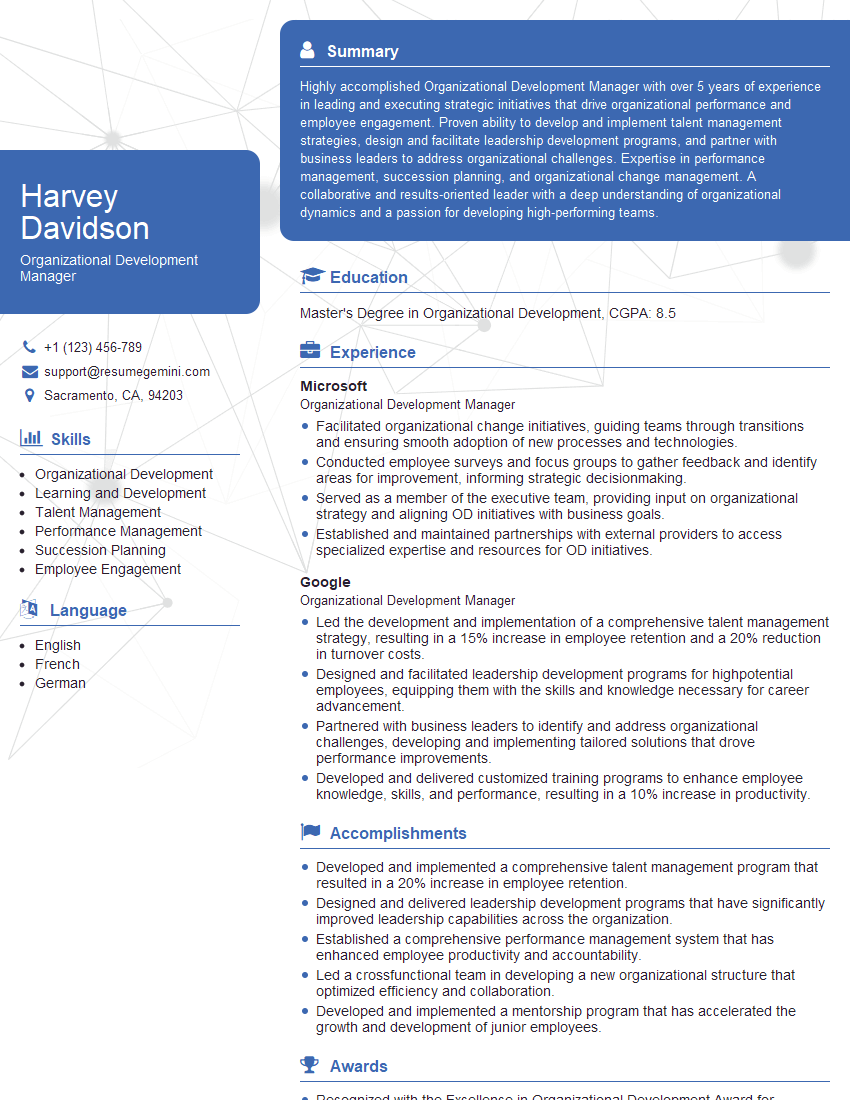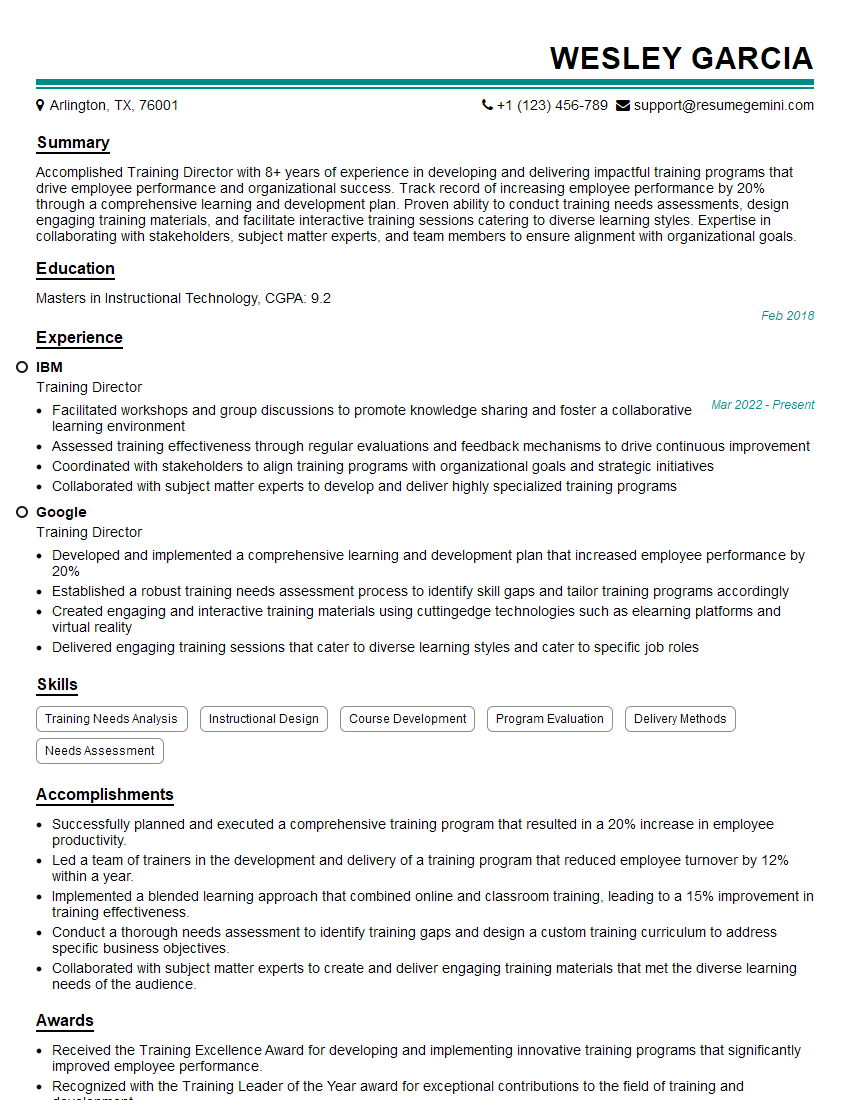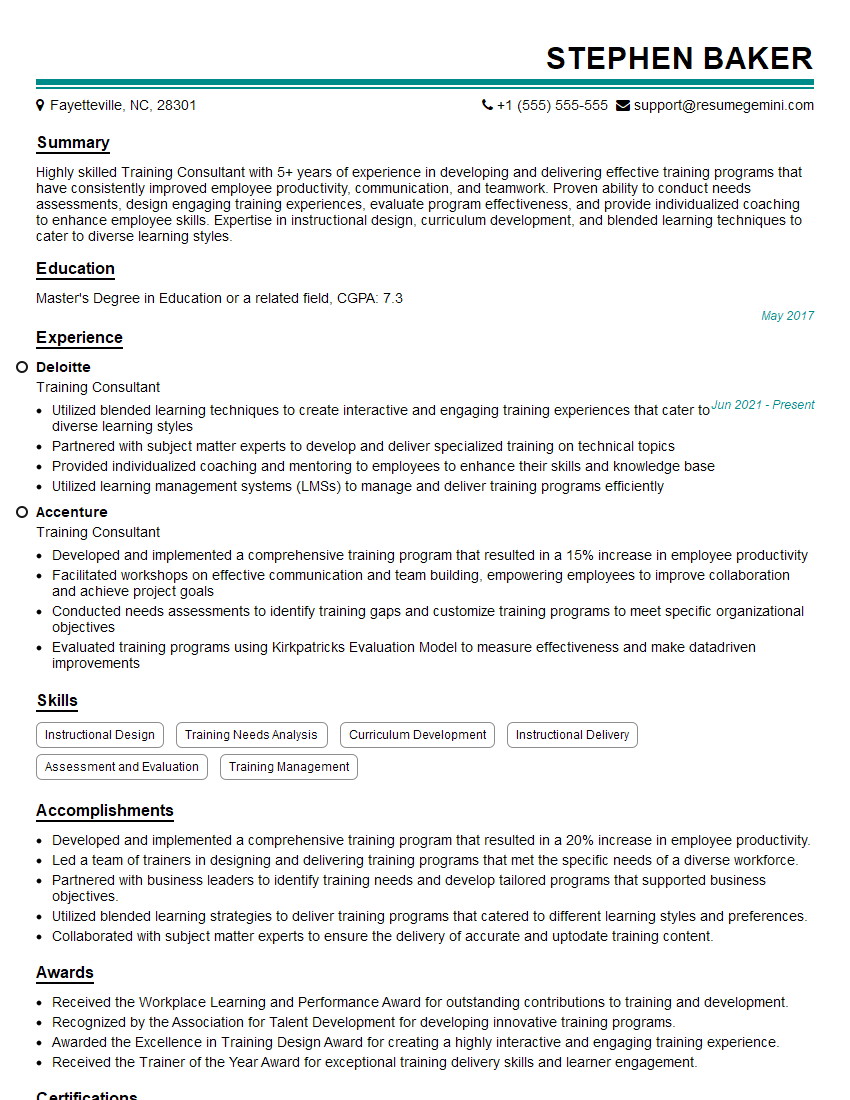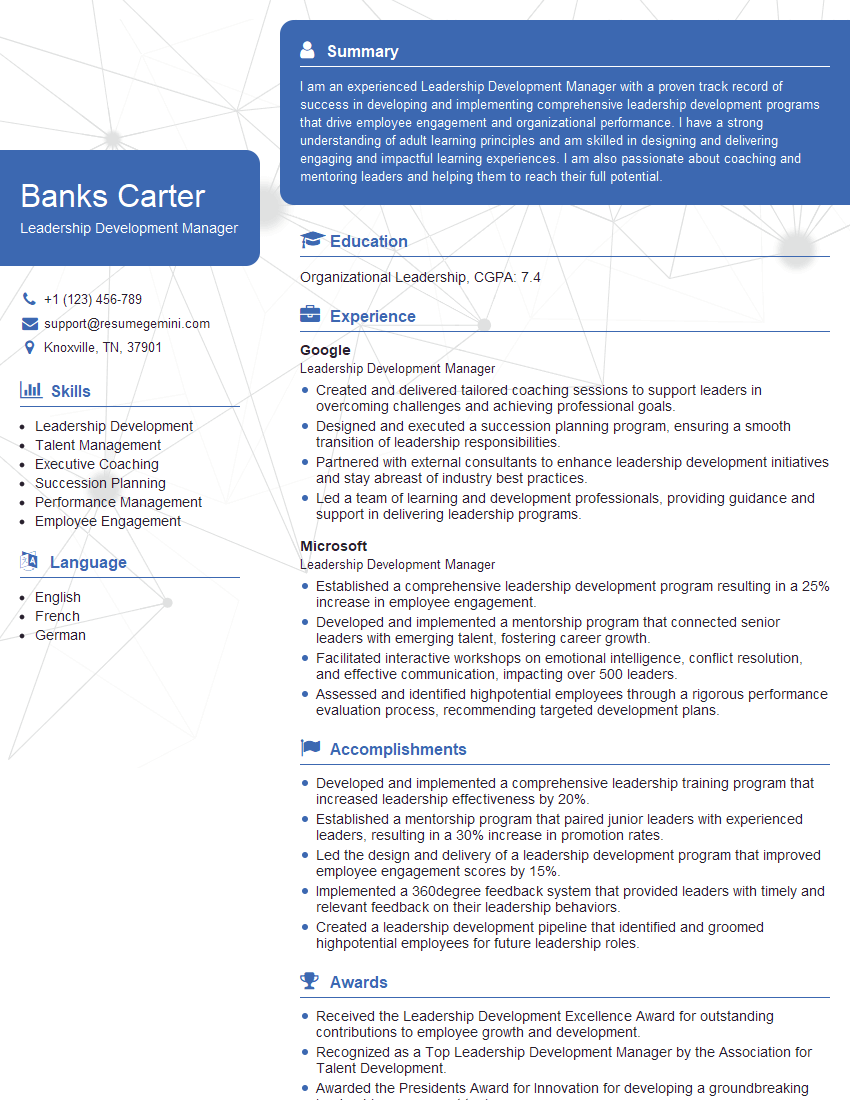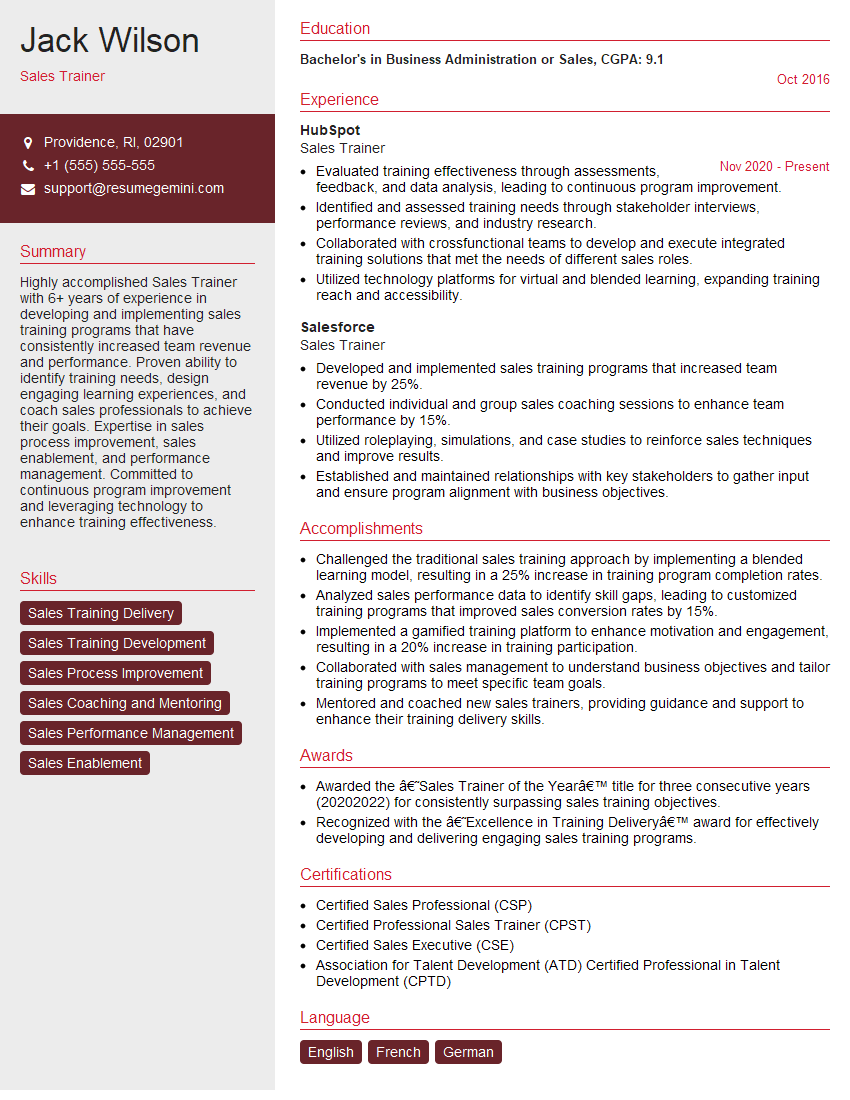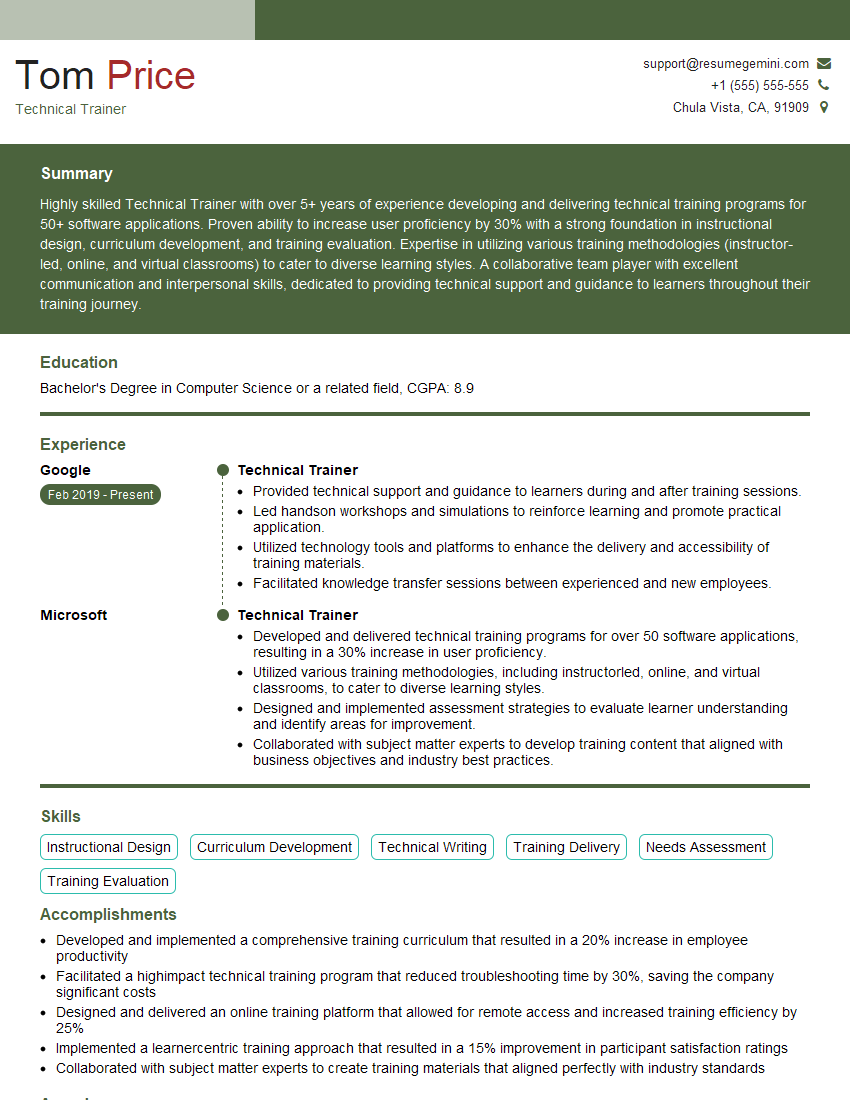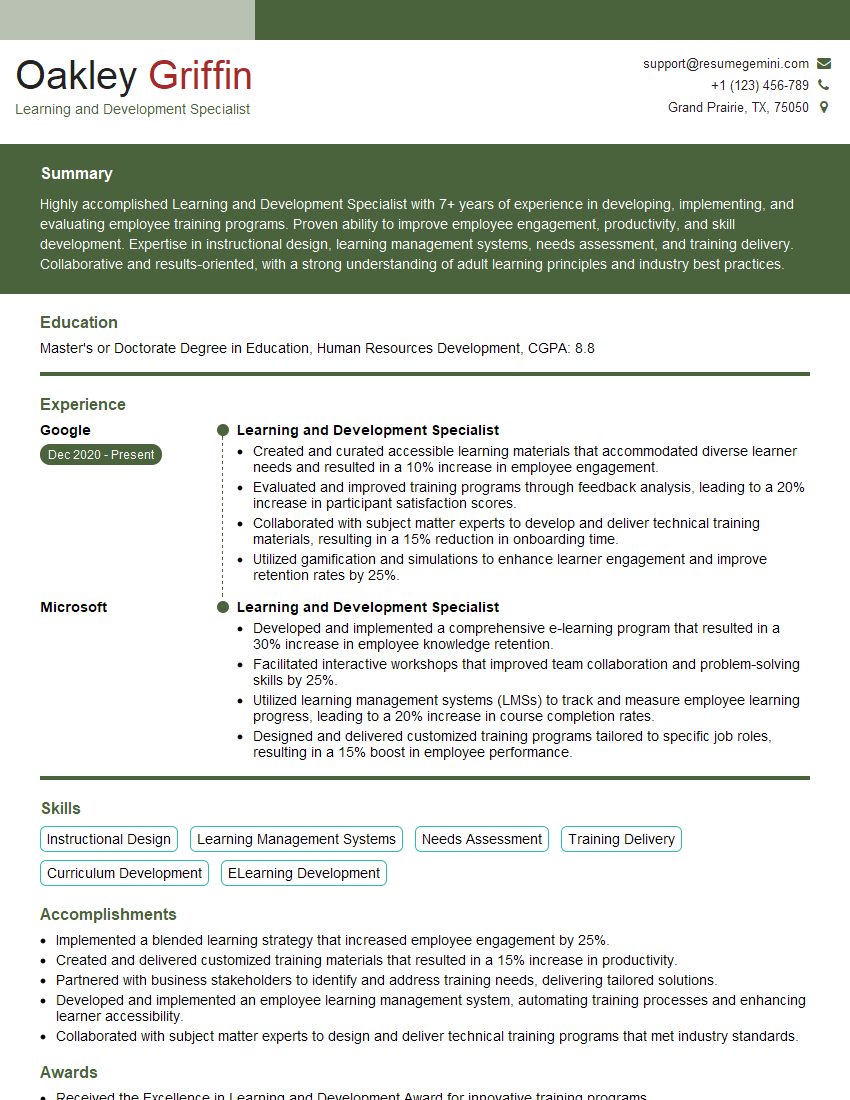The right preparation can turn an interview into an opportunity to showcase your expertise. This guide to Training and Monitoring of Staff interview questions is your ultimate resource, providing key insights and tips to help you ace your responses and stand out as a top candidate.
Questions Asked in Training and Monitoring of Staff Interview
Q 1. Describe your experience in needs analysis for training programs.
Needs analysis is the cornerstone of any effective training program. It’s the process of systematically identifying the gap between current employee performance and desired performance. This involves understanding the organization’s strategic goals, analyzing individual and team skill gaps, and determining the specific knowledge, skills, and attitudes (KSAs) needed to bridge that gap.
My approach typically involves a multi-faceted investigation. I start with reviewing organizational documents like strategic plans and performance reviews to pinpoint areas needing improvement. Then, I conduct interviews with managers, supervisors, and employees to gather firsthand insights on performance challenges and training needs. I might also use surveys, observations, and performance data analysis (like sales figures or error rates) to quantify the extent of the skill gap. For example, if sales figures are consistently below target and observations reveal a lack of effective sales techniques, a training program focusing on those techniques would be identified as a need.
Finally, I consolidate my findings into a comprehensive report outlining the training needs, prioritizing them based on urgency and impact, and proposing potential training solutions. This ensures that the training program directly addresses the organization’s needs, maximizing its effectiveness and return on investment.
Q 2. How do you evaluate the effectiveness of a training program?
Evaluating training effectiveness isn’t simply about measuring participation; it’s about assessing whether the training led to lasting improvements in performance. I employ a blended approach using both formative and summative evaluation methods. Formative evaluation happens *during* the training, using techniques like quizzes, feedback sessions, and observation to make adjustments as needed. Think of it as quality control during the manufacturing process.
Summative evaluation happens *after* the training, focusing on the long-term impact. This often includes measuring changes in employee performance using key performance indicators (KPIs), such as improved productivity, reduced error rates, or increased sales. I also often use post-training assessments, 360-degree feedback, and follow-up interviews to gather qualitative data on the program’s impact on employee knowledge, skills, attitudes, and on-the-job behavior. For instance, I might compare error rates before and after training on a specific software to determine effectiveness. A significant reduction would indicate success.
Q 3. What methods do you use to track employee performance after training?
Tracking employee performance post-training is crucial for demonstrating ROI and identifying areas for improvement. My methods vary depending on the training’s goals and the nature of the employee’s work. I utilize a combination of techniques to build a holistic view.
- Performance monitoring systems: Using existing performance management systems to track key metrics relevant to the training. For example, if the training was on customer service, I might monitor customer satisfaction scores.
- Direct observation: Observing employees on the job to assess the application of newly learned skills and knowledge. This provides valuable qualitative data beyond numbers.
- Performance appraisals: Incorporating training-related goals and competencies into performance reviews to evaluate the impact of training on employee performance.
- Regular feedback sessions: Providing consistent feedback to employees to reinforce learned behaviors and address any challenges they may encounter in applying their new skills.
It’s important to establish clear expectations and measurable goals *before* the training to ensure accurate tracking and evaluation of progress.
Q 4. Explain your experience with different training delivery methods (e.g., online, in-person, blended).
I have extensive experience with various training delivery methods, recognizing that the optimal approach depends on the audience, content, budget, and learning objectives.
- In-person training: This method allows for direct interaction, immediate feedback, and a strong sense of community. It’s particularly effective for hands-on training or when building rapport is important. I’ve successfully used this method for leadership development workshops and technical skill training.
- Online training: E-learning platforms offer flexibility, scalability, and cost-effectiveness. I often incorporate interactive modules, videos, and assessments into online courses to maintain engagement. This is ideal for large groups of employees geographically dispersed or for delivering standardized training consistently. I’ve designed and implemented several successful online compliance training programs.
- Blended learning: This combines the best of both worlds, integrating online modules with in-person workshops or coaching sessions. For example, employees might complete online modules at their own pace before attending a facilitated workshop to apply their knowledge and receive personalized feedback. This provides a personalized and effective approach.
I tailor my approach to the specific needs of each training program, optimizing for effectiveness and engagement.
Q 5. How do you handle resistance to training among employees?
Resistance to training is common, but rarely insurmountable. My approach focuses on understanding the root cause of the resistance before implementing strategies to overcome it.
I start by actively listening to employees’ concerns. Is it fear of the unknown, lack of perceived relevance to their job, time constraints, or past negative training experiences? Once identified, I can address these concerns proactively. For example, if time is an issue, I might offer flexible training schedules or shorter, more focused modules. If relevance is a concern, I highlight the connection between the training and their job responsibilities and career advancement opportunities.
I find that involving employees in the design and delivery of training increases buy-in. Making training engaging and interactive, highlighting success stories from previous participants, and providing clear benefits to participation are also effective strategies. Addressing concerns openly and honestly is vital in building trust and overcoming resistance.
Q 6. What are some key performance indicators (KPIs) you use to measure training success?
Key performance indicators (KPIs) are crucial for measuring training success. The specific KPIs depend on the training’s objectives, but common ones include:
- Improved performance metrics: Increased productivity, reduced error rates, higher sales figures, improved customer satisfaction scores, etc.
- Knowledge retention: Measured through post-training assessments and knowledge checks.
- Skill application: Observed through on-the-job performance, supervisor feedback, and 360-degree reviews.
- Employee satisfaction: Measured through training feedback surveys and participant engagement levels.
- Return on investment (ROI): Calculated by comparing the cost of the training to the financial benefits it generates.
By tracking these KPIs, I can demonstrate the value of the training program to stakeholders and identify areas needing further improvement.
Q 7. Describe your experience developing training materials.
Developing effective training materials is a skill honed over years of experience. I approach it systematically, ensuring the materials are engaging, relevant, and easily understood by the target audience.
My process typically starts with defining clear learning objectives. What knowledge, skills, and attitudes should participants gain after completing the training? This guides the content development. I then create a detailed outline, structuring the information logically and incorporating diverse learning methods – videos, interactive exercises, case studies, simulations, and gamification to enhance engagement. I always consider the learners’ prior knowledge and preferred learning styles.
I prioritize visual appeal, using clear graphics, concise language, and accessible formats. Thorough testing is crucial; I conduct pilot tests with a small group of learners to gather feedback and refine the materials before broader deployment. The feedback loop is essential to improve content clarity and effectiveness.
Q 8. How do you ensure training content is engaging and relevant?
Engaging and relevant training content is crucial for effective learning. It’s not just about delivering information; it’s about making that information stick. I achieve this through a multi-pronged approach. First, I conduct thorough needs assessments to understand the specific skills gaps and the context in which employees will apply their new knowledge. This allows me to tailor the content to their actual needs, rather than delivering generic information.
Secondly, I incorporate various engaging methodologies. This includes interactive elements like simulations, games, case studies, and group discussions, replacing lengthy lectures with active learning experiences. For example, instead of a lecture on customer service, I might use a role-playing scenario where employees practice handling difficult customer interactions.
Finally, I ensure the content is relevant by using real-world examples, relatable scenarios, and showcasing the direct impact of the training on their daily work. Regular feedback loops throughout the training process also help refine content to ensure maximum impact.
Q 9. How do you adapt training materials to different learning styles?
Recognizing that learners have different preferences is fundamental to effective training. I cater to diverse learning styles by employing a blended learning approach that utilizes a variety of methods. This includes:
- Visual Learners: I incorporate charts, diagrams, videos, and presentations rich in visuals.
- Auditory Learners: I utilize discussions, lectures, podcasts, and audio-based learning materials.
- Kinesthetic Learners: I incorporate hands-on activities, simulations, role-playing, and practical exercises.
- Reading/Writing Learners: I provide comprehensive handouts, articles, and opportunities for reflection and journaling.
Furthermore, I offer self-paced learning modules allowing learners to control the pace and method of their learning. This flexibility empowers individuals to choose the approach that best suits their learning style, ensuring inclusivity and maximizing comprehension.
Q 10. What is your experience with learning management systems (LMS)?
I have extensive experience with various Learning Management Systems (LMS), including Moodle, Canvas, and Cornerstone OnDemand. My expertise encompasses not only using these platforms to deliver training but also configuring, managing, and reporting on learner progress. I’m proficient in designing courses within the LMS, creating assessments, tracking completion rates, and generating reports to measure the effectiveness of training initiatives.
For instance, in a previous role, I implemented a new LMS, migrating all existing training materials and developing new courses. This involved training staff on the new system, customizing its features to meet our organization’s needs, and setting up automated reporting to monitor progress and identify areas for improvement. I also leverage LMS analytics to tailor future training, ensuring the resources align perfectly with employee needs and learning outcomes.
Q 11. How do you assess employee learning needs?
Assessing employee learning needs is the cornerstone of effective training. My approach involves a multi-faceted strategy. It begins with a thorough analysis of the organization’s strategic goals and how individual roles contribute to achieving those goals. This helps identify the critical skills required for success.
Next, I use several tools to collect data. This includes performance reviews, 360-degree feedback, skills gap analysis surveys, interviews with managers and employees, and observation of employees in their work environment. This provides a holistic picture of individual and team skill levels, and areas requiring improvement.
Finally, I analyze the gathered data to identify specific training needs. This could involve addressing technical skill gaps, improving soft skills like communication or teamwork, or introducing new procedures and regulations. This data-driven approach ensures the training program directly addresses the organization’s and employees’ actual needs, making it highly impactful and cost-effective.
Q 12. How do you create a positive learning environment?
Creating a positive learning environment is critical for fostering engagement and knowledge retention. This involves a combination of factors. Firstly, I ensure the physical learning space (if applicable) is comfortable, well-equipped, and conducive to collaboration. This might involve providing comfortable seating, adequate lighting, and access to technology.
Secondly, I cultivate a psychologically safe learning environment where participants feel comfortable asking questions, sharing their thoughts, and making mistakes without fear of judgment. This includes establishing clear expectations, building trust and rapport with learners, and encouraging open communication.
Thirdly, I actively foster collaboration and peer-to-peer learning through activities like group work, discussions, and peer feedback. This not only makes learning more engaging but also helps create a sense of community among learners. Regular positive reinforcement and recognition of learner progress also boosts morale and motivation.
Q 13. How do you manage the budget for training programs?
Budget management for training programs requires careful planning and resource allocation. I begin by aligning training costs with the organization’s overall strategic goals, ensuring that the investment in training directly contributes to business objectives. I then create a detailed budget that outlines all anticipated costs, including instructor fees, materials, technology, venue rental (if applicable), and marketing.
To optimize costs, I explore various options. This includes leveraging existing resources, using cost-effective training methods (e.g., online learning), negotiating favorable rates with vendors, and potentially using internal resources to deliver some training. Regular monitoring of the budget against actual expenditures, and proactively addressing any discrepancies, is critical.
Finally, I measure the return on investment (ROI) of the training program by assessing improvements in employee performance, productivity, and overall organizational effectiveness. This data helps justify the training budget and informs future allocation decisions. A cost-benefit analysis helps demonstrate the long-term value of the training investment.
Q 14. Describe your experience with performance improvement plans.
Performance improvement plans (PIPs) are a structured process designed to address performance deficiencies and help employees improve their performance. My experience includes developing and implementing PIPs in various settings. I always approach this process with a focus on collaboration and support, aiming to help the employee succeed.
The process usually begins with a clear identification of the performance gaps, documented with specific examples. The employee and manager then collaboratively create a plan outlining the areas for improvement, the specific steps the employee needs to take, the timeline for achieving these goals, and the support that will be provided. This plan is then formally documented and signed by both parties. Regular check-ins are scheduled to monitor progress and provide ongoing support and feedback.
It’s important to emphasize that PIPs are not solely punitive; they are meant to be a constructive tool to help employees improve and succeed. Regular communication, ongoing support, and a focus on clear, achievable goals are crucial for the success of any PIP.
Q 15. How do you handle employee performance issues related to training?
Addressing performance issues stemming from training requires a multi-faceted approach. It starts with identifying the root cause. Is the performance gap due to inadequate training content, insufficient practice opportunities, a lack of clarity in expectations, or perhaps something entirely unrelated to training?
My approach involves:
- One-on-one meetings: I’d meet with the employee to understand their perspective, identify any obstacles they faced during training, and assess their comprehension of the material.
- Performance review analysis: Examining performance reviews helps pinpoint specific areas where training may have fallen short or where additional support is needed.
- Skills gap analysis: This involves identifying the specific skills lacking and determining whether further training, coaching, or mentoring is required.
- Developing a personalized action plan: Based on the analysis, I collaborate with the employee to create a plan outlining specific goals, steps, timelines, and resources needed to address the performance issue. This might include additional training modules, on-the-job coaching, or mentorship opportunities.
- Regular follow-ups: I would schedule regular check-ins to track progress, provide support, and adjust the plan as needed. This demonstrates a commitment to the employee’s success.
For example, I once worked with a sales representative whose closing rates were consistently below target. After reviewing their training records and conducting an interview, we discovered they lacked confidence in handling objections. We developed a tailored training module focusing on objection handling techniques and role-playing exercises. Regular follow-ups and coaching resulted in a significant improvement in their closing rates within three months.
Career Expert Tips:
- Ace those interviews! Prepare effectively by reviewing the Top 50 Most Common Interview Questions on ResumeGemini.
- Navigate your job search with confidence! Explore a wide range of Career Tips on ResumeGemini. Learn about common challenges and recommendations to overcome them.
- Craft the perfect resume! Master the Art of Resume Writing with ResumeGemini’s guide. Showcase your unique qualifications and achievements effectively.
- Don’t miss out on holiday savings! Build your dream resume with ResumeGemini’s ATS optimized templates.
Q 16. What is your experience with coaching and mentoring employees?
Coaching and mentoring are integral parts of my approach to employee development. I believe in fostering a supportive and collaborative environment where employees feel empowered to grow professionally.
My experience includes:
- Providing constructive feedback: I focus on providing specific, actionable feedback, framing it positively and concentrating on areas for improvement rather than dwelling on past mistakes.
- Setting clear goals and expectations: I work with each employee to define SMART (Specific, Measurable, Achievable, Relevant, Time-bound) goals that align with both their aspirations and the organization’s objectives.
- Facilitating skill development: I guide employees through the process of identifying their skill gaps and developing strategies to overcome them, utilizing both formal and informal learning methods.
- Building confidence and motivation: I strive to create a safe space where employees feel comfortable taking risks, experimenting, and learning from their mistakes. I celebrate their successes, recognizing their achievements along the way.
- Mentoring junior employees: I’ve mentored many junior employees, offering guidance on navigating workplace challenges and fostering professional growth. This involves not just skill development, but also career guidance and organizational navigation.
For instance, I recently mentored a new project manager who struggled with delegating tasks effectively. By providing a combination of training, practical advice, and observational feedback, I helped them develop the confidence and skills to lead their team more successfully.
Q 17. How do you ensure consistency in training delivery across different locations or departments?
Ensuring training consistency across multiple locations and departments is crucial for maintaining quality and achieving organizational objectives. This requires a structured and standardized approach.
My strategies include:
- Standardized training materials: I develop comprehensive training materials (e.g., manuals, presentations, videos, online modules) that are consistently applied across all locations and departments. This ensures a unified training experience.
- Centralized training platform: Utilizing a Learning Management System (LMS) ensures that all employees have access to the same updated training resources, regardless of location.
- Train-the-trainer programs: I conduct train-the-trainer sessions to equip internal trainers in different locations with the skills and knowledge to deliver training effectively and consistently. This ensures uniform delivery and quality control.
- Regular audits and feedback: Periodic audits of training delivery across different sites and departments allow for timely identification and resolution of inconsistencies. Feedback mechanisms are key to identifying areas for improvement.
- Regular updates: Training content should be regularly reviewed and updated to reflect changes in procedures, regulations, or best practices. This ensures that the training remains relevant and up-to-date.
For example, in my previous role, we used a centralized LMS to deliver compliance training to our staff across five different offices. This ensured everyone received the same information, and we could track completion rates and assess overall understanding.
Q 18. How do you incorporate feedback from trainees to improve training programs?
Trainee feedback is invaluable for improving training programs and ensuring their effectiveness. It provides insights into areas that resonate well, those that need improvement, and areas where trainees may be struggling.
My methods for incorporating feedback include:
- Post-training surveys: I use online surveys to gather quantitative and qualitative data on trainee satisfaction, the effectiveness of the training, and areas needing improvement.
- Focus groups: Conducting focus groups with small groups of trainees allows for more in-depth discussions and the identification of underlying issues.
- Individual feedback sessions: One-on-one conversations with trainees offer personalized insights and allow for a more targeted approach to addressing specific concerns.
- Observation and monitoring: Observing trainees during practical exercises provides real-time feedback and allows for adjustments during the training itself.
- Analyzing training data: Metrics such as completion rates, test scores, and post-training performance data provide objective measures of training effectiveness. This data can inform improvements to training materials and delivery methods.
For example, feedback from a recent training session revealed that trainees found a particular module overly complex. As a result, I rewrote the module, using simpler language and more illustrative examples, resulting in significantly improved comprehension scores in subsequent sessions.
Q 19. What is your experience with compliance training?
I have extensive experience with compliance training, including programs related to workplace safety, data privacy (GDPR, CCPA), anti-bribery (FCPA), and anti-harassment policies. Compliance training is crucial for mitigating legal and ethical risks.
My approach to compliance training focuses on:
- Understanding regulatory requirements: Thoroughly understanding all relevant regulations and best practices is crucial to designing effective and legally compliant training programs.
- Engaging content: Compliance training can often be perceived as dry and tedious. I focus on creating engaging and interactive content that encourages active learning and knowledge retention (using scenarios, case studies, gamification techniques).
- Regular updates: Compliance regulations are constantly evolving. Therefore, regular updates to the training materials are vital to ensure that employees remain informed and compliant.
- Tracking and documentation: Maintaining accurate records of employee training completion, assessments, and any subsequent remedial actions is essential for demonstrating compliance to auditors. Utilizing an LMS streamlines this process.
- Testing and assessment: I incorporate regular assessments to ensure that trainees understand and can apply the learned material.
For instance, I recently developed a GDPR compliance training program for a multinational corporation, ensuring that all employees, regardless of their location or role, understood their responsibilities under the new regulations.
Q 20. How do you measure the return on investment (ROI) of training programs?
Measuring the ROI of training programs is crucial for demonstrating their value and justifying investment. A comprehensive approach is needed, encompassing both quantitative and qualitative measures.
My methods for measuring ROI include:
- Pre- and post-training assessments: Comparing employee performance before and after training reveals improvements in skills and knowledge.
- Performance metrics: Tracking key performance indicators (KPIs) such as productivity, sales, error rates, customer satisfaction, and employee turnover rates before and after training helps demonstrate the impact of the program on business outcomes.
- Return on investment calculations: This involves quantifying the costs of the training program (e.g., materials, instructor fees, employee time) and comparing them to the financial benefits derived from improved performance. For example, reduced error rates or increased sales.
- Employee surveys and feedback: Gathering data on employee satisfaction, engagement, and perceived value of training can offer valuable insights.
- Qualitative measures: Analyzing qualitative data from employee feedback, observations, and case studies can provide a richer understanding of the training’s impact on organizational culture, morale, and employee development.
For instance, in one project, we calculated the ROI of a sales training program by comparing the increased sales revenue generated by trained employees to the total cost of the program. The positive ROI demonstrated the program’s value and justified future investments in similar initiatives.
Q 21. Describe your experience with onboarding new employees.
Onboarding is crucial for setting new employees up for success and ensuring a smooth transition into the organization. My approach focuses on creating a positive and productive initial experience.
My onboarding process typically includes:
- Pre-boarding: I initiate contact before the employee’s start date, providing essential information such as paperwork, IT setup instructions, and information about the company culture and expectations.
- Orientation: The first day includes a welcome session, introductions to key personnel, a tour of the facilities, and an overview of company policies and procedures.
- Structured training program: A structured training program covering essential job skills and company-specific procedures.
- Mentorship or buddy system: Pairing the new employee with a mentor or buddy to provide guidance and support during the initial weeks and months.
- Regular check-ins: Regular meetings with the new employee to track their progress, address any challenges, and provide ongoing support.
- 30-60-90 day goals: Setting clear expectations and goals for the first three months to provide direction and focus.
For example, in my previous role, we implemented a comprehensive onboarding program that included a week-long orientation, job-specific training, and a mentorship program. This resulted in significantly improved employee retention and faster time-to-productivity for new hires.
Q 22. How do you address diverse learning needs in your training programs?
Addressing diverse learning needs is crucial for effective training. My approach involves a multifaceted strategy that considers various learning styles, technological proficiency, and cultural backgrounds. I begin by conducting a thorough needs analysis, identifying the specific learning preferences and challenges of each participant. This might involve surveys, interviews, or observations.
- Differentiated Instruction: I design training modules with varied activities. This includes visual aids, interactive exercises, hands-on simulations, and group discussions to cater to different learning styles (visual, auditory, kinesthetic). For example, a technical training program might include video tutorials for visual learners, audio podcasts for auditory learners, and practical lab sessions for kinesthetic learners.
- Accessibility Considerations: I ensure all materials are accessible to individuals with disabilities, adhering to accessibility guidelines (like WCAG). This could involve providing transcripts for videos, alternative text for images, and adjustable font sizes.
- Multilingual Support: For diverse language backgrounds, I incorporate translations or multilingual support, perhaps using subtitles or employing interpreters.
- Adaptive Learning Technologies: I leverage adaptive learning platforms that personalize the learning experience based on individual progress and needs. These systems adjust the difficulty and pace of learning based on each learner’s performance.
By employing this multi-pronged approach, I create an inclusive environment where all trainees can thrive and reach their full potential.
Q 23. What is your experience with different training evaluation methods?
My experience encompasses a wide range of training evaluation methods, both formative and summative. Formative evaluations assess learning during the training process, allowing for adjustments. Summative evaluations measure learning outcomes after the training is complete.
- Kirkpatrick’s Four Levels: I regularly utilize Kirkpatrick’s model, assessing reaction (trainee satisfaction), learning (knowledge gained), behavior (application on the job), and results (impact on organizational goals). For example, I might use post-training surveys for reaction, knowledge tests for learning, observation for behavior, and performance metrics for results.
- Pre- and Post-Tests: These measure knowledge gain directly. I use pre-tests to establish a baseline and post-tests to measure the increase in knowledge after the training.
- Performance-Based Assessments: Simulations or real-world tasks evaluate the ability to apply knowledge and skills practically. For instance, a sales training program might involve role-playing scenarios with customers.
- 360-Degree Feedback: This gathers feedback from multiple sources (supervisors, peers, subordinates, and self) to provide a holistic view of performance improvements after training.
- Return on Investment (ROI) Analysis: This quantifies the financial benefits of the training program by measuring factors such as increased productivity, reduced errors, and improved customer satisfaction.
The choice of evaluation method depends on the specific training objectives and available resources. A combination of methods often yields the most comprehensive and accurate evaluation.
Q 24. How do you stay current with best practices in training and development?
Staying current in the field of training and development requires continuous learning. I actively engage in several strategies:
- Professional Development Courses: I regularly attend workshops, seminars, and conferences focusing on innovative training methodologies, technologies, and best practices.
- Industry Publications and Journals: I subscribe to and read publications like Training magazine and ATD (Association for Talent Development) journals to stay abreast of current trends and research.
- Online Learning Platforms: I utilize online learning platforms like Coursera, edX, and LinkedIn Learning to access specialized courses in areas such as instructional design, e-learning development, and leadership training.
- Networking with Peers: I participate in professional organizations (like ATD) and engage with other training professionals through online forums and communities to exchange ideas and learn from their experiences.
- Research and Case Studies: I conduct research on successful training programs and case studies to discover what works best in various contexts.
This holistic approach keeps my knowledge and skills aligned with the latest trends and ensures I’m constantly improving my training delivery capabilities.
Q 25. Describe a time you had to adapt a training program due to unforeseen circumstances.
During a leadership training program, a key speaker unexpectedly cancelled two days before the event. This posed a significant challenge as the speaker’s session was a crucial component.
My immediate response was to activate my contingency plan. I had already identified backup speakers for each session, and I immediately contacted the alternative speaker for that specific module. Luckily, they were available and readily prepared to adapt their presentation to fit the allotted time. To mitigate any disruption, I promptly communicated the change to the participants, explaining the situation and reassuring them that the program’s overall quality would be maintained.
In addition, to compensate for the unforeseen circumstances, I incorporated a brief Q&A session with all participants to address any concerns or questions they might have had regarding the change. The feedback received after the event was overwhelmingly positive, highlighting the value of having a robust contingency plan and proactive communication in place.
Q 26. What are some challenges you’ve faced in delivering training programs, and how did you overcome them?
One significant challenge I encountered was managing participant engagement during online training sessions. The lack of face-to-face interaction can lead to disengagement and reduced learning.
To overcome this, I implemented several strategies:
- Interactive Activities: I incorporated more frequent interactive activities like polls, quizzes, breakout rooms, and collaborative projects to keep participants actively involved.
- Short, Focused Sessions: Instead of long, uninterrupted sessions, I broke the training into shorter, more focused modules with regular breaks.
- Gamification: I introduced elements of gamification, such as points, badges, and leaderboards, to enhance motivation and engagement.
- Regular Check-Ins: I conducted regular check-ins with participants to monitor their progress, address questions, and offer support.
- Use of Technology: I leveraged online whiteboards, collaborative document editors, and screen-sharing tools to facilitate interaction.
These changes significantly improved participant engagement and satisfaction, leading to better learning outcomes. This experience underscored the importance of adapting training delivery methods to suit the specific learning environment and address potential challenges proactively.
Q 27. How do you ensure that training aligns with organizational goals?
Aligning training with organizational goals is fundamental for achieving maximum impact. My process involves:
- Needs Analysis: I begin by conducting a thorough needs analysis to identify the skills and knowledge gaps that are hindering the organization from achieving its strategic objectives. This involves discussions with key stakeholders across different departments to understand their specific needs and priorities.
- Strategic Alignment: I ensure that the training content directly addresses the identified skill gaps and contributes to the achievement of organizational goals, using a framework that connects training objectives to broader company strategies. For example, if the company’s goal is to improve customer satisfaction, the training program might focus on enhancing customer service skills.
- Performance Metrics: I define clear and measurable performance metrics to track the effectiveness of the training program in achieving its objectives. This allows for the continuous improvement of training programs, ensuring that they remain aligned with organizational goals.
- Regular Evaluation: I conduct regular evaluations of the training program to assess its effectiveness in achieving its intended goals. This helps to identify any areas where improvements are needed and ensures that the training program remains relevant and effective over time.
By systematically connecting training initiatives to organizational objectives, I maximize the return on investment and ensure that training serves as a catalyst for organizational success.
Q 28. What is your approach to providing constructive feedback to employees?
Providing constructive feedback is a crucial aspect of employee development. My approach focuses on being specific, actionable, and supportive.
- Specific Examples: Instead of general statements, I provide specific examples of behavior, outlining what was done well and what could be improved. For example, instead of saying “Your communication needs improvement,” I’d say, “During the recent client meeting, your tone could have been more collaborative. Consider using phrases like ‘I understand your concerns’ to build rapport.”
- Focus on Behavior, Not Personality: I concentrate on the behavior itself, avoiding personal attacks or judgments. This helps employees focus on improvement without feeling discouraged.
- Balanced Feedback: I provide a balanced perspective, highlighting both strengths and areas for development. This encourages a growth mindset and motivates employees to work on improvements.
- Actionable Steps: I offer concrete suggestions and actionable steps for improvement. For example, I might recommend specific resources, training courses, or mentoring opportunities.
- Two-Way Conversation: I encourage a two-way conversation, actively listening to the employee’s perspective and creating a space for open discussion and collaboration.
- Positive and Encouraging Tone: I maintain a positive and encouraging tone, focusing on helping the employee grow and develop. Even critical feedback is delivered with a supportive approach.
By following these guidelines, I aim to ensure that feedback is received positively, resulting in improved performance and employee growth.
Key Topics to Learn for Training and Monitoring of Staff Interview
- Needs Assessment & Curriculum Design: Identifying training gaps, designing effective training programs tailored to different learning styles, and aligning training with organizational goals. Practical application: Developing a training plan for new software implementation, considering various employee skill levels.
- Training Delivery Methods: Mastering various training methodologies (e.g., on-the-job training, workshops, e-learning) and selecting the most appropriate method based on learning objectives and audience. Practical application: Choosing the best delivery method for a complex technical skill, justifying your choice.
- Performance Monitoring & Evaluation: Establishing clear performance metrics, using appropriate tools and techniques to track employee progress, providing constructive feedback, and identifying areas for improvement. Practical application: Designing a performance evaluation system for a sales team, including key performance indicators (KPIs).
- Coaching & Mentoring: Understanding the differences between coaching and mentoring, and applying these approaches to enhance employee performance and development. Practical application: Describing a situation where you successfully coached or mentored an employee to overcome a performance challenge.
- Compliance & Regulatory Issues: Understanding relevant legal and regulatory requirements related to training and employee development. Practical application: Explaining how you would ensure compliance with relevant regulations in a training program.
- Technology in Training & Monitoring: Utilizing technology (LMS, performance management software) to enhance training effectiveness and streamline monitoring processes. Practical application: Describing your experience with Learning Management Systems (LMS) and their benefits.
- Budgeting & Resource Allocation: Effectively managing training budgets and allocating resources to maximize the impact of training initiatives. Practical application: Justifying the cost of a specific training program based on its projected ROI.
Next Steps
Mastering Training and Monitoring of Staff is crucial for career advancement, opening doors to leadership and management roles. A strong resume is your key to unlocking these opportunities. Creating an ATS-friendly resume is vital to getting your application noticed. ResumeGemini is a trusted resource to help you build a professional and impactful resume that highlights your skills and experience in this field. Examples of resumes tailored to Training and Monitoring of Staff roles are available to help you create a winning application. Take the next step toward your dream career – build your best resume today!
Explore more articles
Users Rating of Our Blogs
Share Your Experience
We value your feedback! Please rate our content and share your thoughts (optional).
What Readers Say About Our Blog
Hi, I represent an SEO company that specialises in getting you AI citations and higher rankings on Google. I’d like to offer you a 100% free SEO audit for your website. Would you be interested?
good
